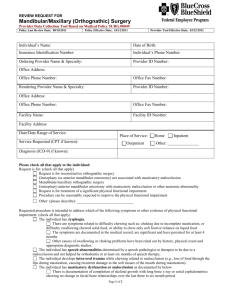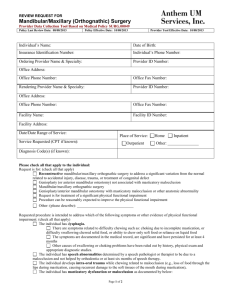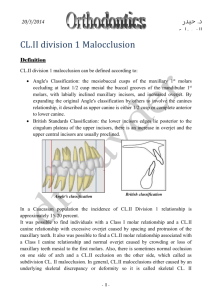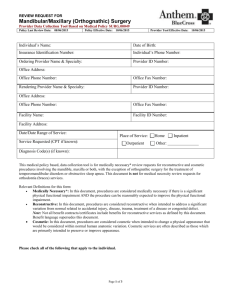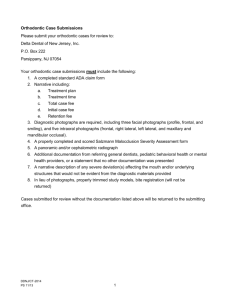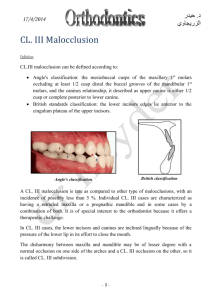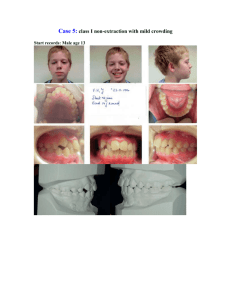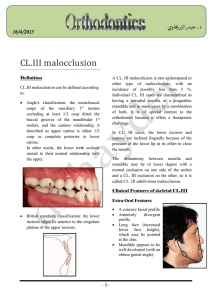Class II Division 1 Malocclusion: Orthodontic Overview
advertisement
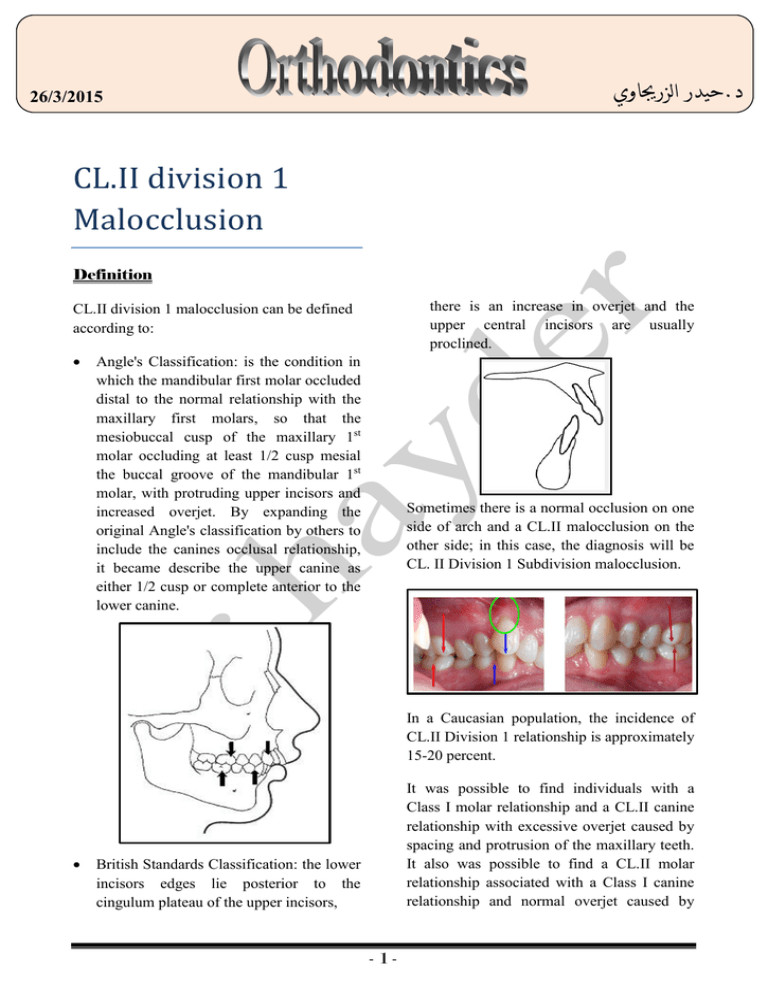
حيدر الزرجياوي.د 26/3/2015 CL.II division 1 Malocclusion Definition there is an increase in overjet and the upper central incisors are usually proclined. CL.II division 1 malocclusion can be defined according to: Angle's Classification: is the condition in which the mandibular first molar occluded distal to the normal relationship with the maxillary first molars, so that the mesiobuccal cusp of the maxillary 1st molar occluding at least 1/2 cusp mesial the buccal groove of the mandibular 1st molar, with protruding upper incisors and increased overjet. By expanding the original Angle's classification by others to include the canines occlusal relationship, it became describe the upper canine as either 1/2 cusp or complete anterior to the lower canine. Sometimes there is a normal occlusion on one side of arch and a CL.II malocclusion on the other side; in this case, the diagnosis will be CL. II Division 1 Subdivision malocclusion. In a Caucasian population, the incidence of CL.II Division 1 relationship is approximately 15-20 percent. It was possible to find individuals with a Class I molar relationship and a CL.II canine relationship with excessive overjet caused by spacing and protrusion of the maxillary teeth. It also was possible to find a CL.II molar relationship associated with a Class I canine relationship and normal overjet caused by British Standards Classification: the lower incisors edges lie posterior to the cingulum plateau of the upper incisors, -1- Orthodontics……….……………………………………………………...…..... Cl. II Div. 1 Malocclusion Intra-Oral Features crowding or loss of maxillary teeth mesial to the first molars. It became clear that Angle's original simplified approach was inadequate to describe the diversity of Class II malocclusion arising from both dental and skeletal origin. 1. CL.II molar relationship indicating distal relationship of mandible to maxilla. 2. Protruding upper incisors with increased overjet. 3. There is a deepbite, which may be traumatic in nature. 4. Deep curve of Spee. 5. Narrow or constricted maxillary arch may present and the palatal vault is usually deep. 6. Other characteristics such as anterior open-bites or posterior cross-bites may be present depending upon the persistence of deleterious habits. In general, the most common Class II malocclusion is one that is caused by an underlying Class II skeletal discrepancy; this is called skeletal CL. II malocclusion. On the other hands, Class II malocclusion that is present in an individual with a normal skeletal jaw relationship is less frequent; it is named dental CL.II malocclusion. Clinical Features Etiology Extra-Oral Features The etiology of CL.II malocclusions is considered multifactorial: 1. In frontal view, face is usually oval (Mesocephalic to Dolichocephalic). 2. In profile view, exhibits a convex profile. 3. Incompetent and stretched upper lip due to proclined incisors. 4. Lower lip is invariably everted and placed behind the upper incisors exhibiting a deep mento-labial sulcus. 5. There is lack of lip seal. Skeletal Factor Most CL.II malocclusions are caused by an underlying skeletal discrepancy or deformity. Skeletal discrepancies associated with CL.II malocclusions have been termed Skeletal CL.II relationships. This term indicates that the CL.II malocclusion is one resulting from an anteroposterior disproportion in size or discrepancy in position of the jaws rather than malpositions of the teeth relative to the jaws (retrusion of mandibular teeth or protrusion of maxillary teeth or both). Skeletal CL.II malocclusions can be subdivided conveniently into those comprised of either mandibular deficiency or maxillary excess. -2- Orthodontics……….……………………………………………………...…..... Cl. II Div. 1 Malocclusion which leads to proclination of the upper incisors with the result that the incisor relationship is more severe than the underlying skeletal pattern. However, if the tongue habitually comes forward to contact the lower lip, proclination of the lower incisors may occur, helping to compensate for the underlying skeletal pattern. Soft Tissues Factor The influence of the soft tissues on a Class II division 1 malocclusion is mainly mediated by the skeletal pattern, both anteroposteriorly and vertically. However, the resting position of the patient's soft tissues and their functional activity also play a part. In a Class II division 1 malocclusion, the lips are typically incompetent owing to the prominence of the upper incisors and/or the underlying skeletal pattern. If the lips are incompetent, the patient will try to achieve an anterior oral seal in one of the following ways: Dental Factors A CL.II div. 1 incisors relationship may occur in the presence of crowding or spacing. Where the upper arch is crowded, lack of space may result in the upper incisors being crowded out of the arch labially and thus to exacerbation of the overjet, or there may be generalized maxillary spacing associated with the protruding maxillary incisors. Mesial drift of the permanent first molars occurs, if there is loss of mesial proximal contact with the second primary molars from congenital absence, extraction, dental caries or ankylosis. In these situations, the maxillary first permanent molar assumes a more mesial position, resulting in a dental CL.II permanent molar relationship. Circumoral muscular activity to achieve a li p-to-lip seal. The mandible is postured forwards to allow the lips to meet at rest. The lower lip is drawn up behind the upper incisors. The tongue is placed forwards between the incisors to contact the lower lip, often contributing to the development of an incomplete overbite: A combination of these. Where the patient can achieve lip-to-lip contact by circumoral muscle activity or the mandible is postured forwards, the influence of the soft tissues is often to moderate the effect of the underlying skeletal pattern by dento-alveolar compensation. More commonly, the lower lip functions by being drawn up behind the upper incisors, -3- Orthodontics……….……………………………………………………...…..... Cl. II Div. 1 Malocclusion Habits Whenever skeletal CL.II problem presents with maxillary excess, the headgear is designed to deliver an adequate extraoral orthopedic force to compress the maxillary sutures, modifying the pattern of bone apposition at these sites. It is intended to restrain anterior and inferior growth of the maxilla, while the mandible continues to grow forward an adequate amount to "catch up" with the maxilla. Persistent habit as digit sucking, tongue, or lip habits will act like an orthodontic force on the teeth resulting in proclination of the upper incisors and retroclination of the lower, and increasing the overjet. These habits can either result in a CL.II malocclusion or accentuate an existing one. Management There are three possible approaches to treatment of CL. II div.1 Malocclusion. Sometime to solve the case, we need a combination between these approaches. They include: 1. Growth modification, by headgear and functional appliances. 2. Dental camouflage, by Removable and fixed appliances. 3. Orthognathic Surgery, by Mandibular advancement and Maxillary impaction. Functional appliances are intraoral devices. CL.II functional appliances are designed to position the mandible downward and forward, so in turn distract the mandibular condyles out of the glenoid fossae reduces the pressure on the actively growing condylar cartilage and alters the muscle tension on the condyles. The result is increasing the amount of mandibular growth more than would normally occur. Growth Modification This approach can be done while the child is still grow. Whenever a skeletal jaw discrepancy exists, it can be corrected by modifying the patient's remaining facial growth, so that the skeletal problem is corrected by more or less growth of one jaw than the other. Treatment strategies of CL. II skeletal problem include restraining the maxillary growth, encourage mandibular growth, or by combination of the two. Limited restrain of maxillary growth also occurs. The success of these appliances was dependent on excellent patient compliance. The functional appliances can be used to reduce the O.J. in: -4- Orthodontics……….……………………………………………………...…..... Cl. II Div. 1 Malocclusion 1. Mild to moderate CL. II Skeletal pattern due to mandibular deficiency. 2. Protrusive maxillary incisors and retrusive mandibular incisors. 3. Well aligned arches. 4. Deepbite. 5. Reduced lower facial height. 6. Cooperative patient. moderate skeletal discrepancy, and have no more than minimal dental crowding. Dental camouflage almost always requires extraction of teeth. For CL.II div.1 malocclusions correction, it is usually necessary to extract maxillary first premolars to gain sufficient space to retract maxillary canines and incisors. Adequate space is available only if there is no excessive protrusion of maxillary incisors. Fixed appliance is usually used to achieve bodily retraction of the upper anterior segment into the extraction space. A wide variety of CL.II functional appliances is available, such as Andresen's activator, bionator, twin block and frankel II. In a limited number of cases, with good aligned arches, no crowding, proclined and spaced upper incisors, the molars relation is CL.I or mild CL.II based on skeletal CL.I pattern, mesio-angular canines, with reduced overbite, a removable appliance can be used to tip back the upper incisors and reduce the overjet in three stages treatment approach: 1st stage: Canine Overbite Reduction Retraction and Retraction of the mesio-angular canines into a class I relationship with the lowers. Retraction occurs either into the spaces distal to canines in case of spacing or to 1st premolar space after their extraction. Sometimes in cases of average or deepbite, a flat anterior bite-plate can be incorporated into the appliance, which is just sufficiently deep to contact the lower incisors evenly. Dental Camouflage Dental camouflage means orthodontic repositioning of teeth in the jaws, so there is an acceptable dental occlusion and esthetic facial appearance. The goal of dental camouflage is to mask the unacceptable skeletal relationship. The dental movement needed in CL.II malocclusion is retraction of maxillary teeth and protraction of mandibular teeth to eliminate overjet and correct buccal occlusion. Dental camouflage treatment should be limited to non-growing patients with mild to -5- Orthodontics……….……………………………………………………...…..... Cl. II Div. 1 Malocclusion 2nd stage: Overjet Reduction In severe skeletal discrepancy, the extent of dental camouflage (maxillary retraction or mandibular protraction) necessary to eliminate the overjet is either too great to permit a stable treatment outcome or too great to permit an esthetic facial result. Once the canines have been retracted into CL.I with the lowers and the overbite has been reduced in deep bite cases, overjet reduction can commence, using a Roberts' retractor. The appliance should incorporate stops mesial to the canines (to prevent their forward relapse) and an anterior bite plate sufficiently thick to maintain the existing overbite reduction. Surgery is also indicated in cases where the lower facial height is significantly increased or reduced, and if severe crowding is present so take all of the extraction space to correct this problem, leaving no additional space to retract maxillary teeth and overjet reduction. In preparation for orthognathic surgery, presurgical orthodontics is necessary in all cases, to place the teeth in a favorable position with their supporting bone, to facilitate proper interdigitation and stabilization at surgery. Postsurgical orthodontics also required to improve occlusal interdigitation. 3rd stage: Retention A mandibular advancement is indicated in most skeletal CL.II cases, where mandibular deficiency is the causative factor of malocclusion. The procedure that is most frequently used currently is the intraoral bilateral sagittal split osteotomy. The reduced overjet requires retention, which is best provided by a purpose-made retainer with Adam's clasps on upper first molars and a Hawley arch on anterior teeth. Orthognathic Surgery Usually the most optimal treatment for a severe skeletal Class II malocclusion in a patient with minimal or no remaining facial growth potential is to directly address the source of the problem with orthognathic surgery. On the other hands, maxillary impaction or maxillary retro-positioning is indicated in cases with vertical maxillary excess or maxillary prognathism respectively. Total or segmental maxillary osteotomy can be used and the both permit the mandible to rotate -6- Orthodontics……….……………………………………………………...…..... Cl. II Div. 1 Malocclusion upward and forward to help correct a skeletal Class II problem. -7-
